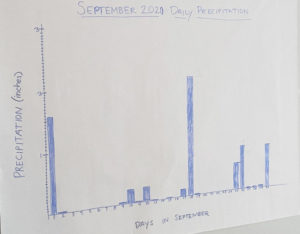Standards + Practices

Science Standards:
ESS.5.1.1 Analyze and interpret data to compare daily and seasonal changes in weather conditions and patterns
ESS.5.1.2 Analyze and interpret weather data to explain current and upcoming weather conditions in a given location.
SP3: Planning and carrying out investigations
SP4: Analyze and interpret data
Math Standards:
NC.5.MD.2 Represent and interpret data: Collect data by asking a question that yields data that changes over time.
NC.5.NBT.3 Read, write, and compare decimals to thousandths.
NC.5.G.1 Graph points in the first quadrant of a coordinate plane.
MP4: Model with mathematics
MP6: Attending to precision
Resources + Supports

Ms. Clark’s Class Graphs Last Month’s Precipitation Data
Plotting each day’s data point on a graph during this activity will help Ms. Clark’s students see patterns in these data and also provide an opportunity to review graphing skills. Knowing that students will be creating their own graphs in the future, Ms. Clark decides to make the class graph on chart paper (with gridlines) that can be displayed as an example in the classroom for students to reference throughout the year.
In her experience teaching, she has noticed that students often find it difficult to decide what to put on the x- versus y-axis. Ms. Clark uses students’ experience collecting precipitation data to illustrate the difference between what belongs on the x-axis (independent variable–in this case, the date) versus y-axis (dependent variable–in this case, the amount of precipitation). With the axes drawn but unlabeled, she asks the class, “What would you say if someone asked you how much it rained?” A student replies, “It would depend on which day they were asking about.” Ms. Clark writes on the chart paper “The amount of precipitation depends on when (what day/what month),” and explains to students how that makes precipitation the dependent variable, which goes on the y-axis. Ms. Clark labels the y-axis “Precipitation” and asks students what the least possible amount of precipitation is, to which they reply “0” and Ms. Clark labels 0 on the graph. Ms. Clark asks all students to share with a partner the greatest amount they saw on a day in September. The class determines 2.25 inches was the greatest amount recorded. Ms. Clark explains that 2.25 is more than 2, but less than 3, and suggests that they end their y-axis at 3. Although Ms. Clark already considered how to label portions of the scale ahead of class, she thinks aloud as she models her process for determining the scale, ultimately determining that each minor grid line would be 0.05. Once the y-axis is labeled with values, Ms. Clark asks students what those values represent and then adds the unit “(inches)” to her axis label. Helping students recognize the date as the independent variable, Ms. Clark labels the x-axis “Days in September” and labels the x-axis 1-30.
Ms. Clark is concerned that her students will find it difficult to plot decimal values, as these are less familiar than whole numbers at this point in the year. For this reason, and because there was no rainfall on several days, Ms. Clark decides to put her students in pairs and assigns each pair one date when they recorded precipitation greater than zero. After plotting multiple zeroes, and modeling for students how to plot another point greater than zero on the class graph, Ms. Clark then asks a couple pairs at a time to mark their point on the graph. Once the graph is complete, Ms. Clark shares that they will keep it in their classroom and reminds students, “We need to title our graph. Otherwise, we may not remember what we’re looking at, or others who come into our classroom may not know.” As a class, they decide to title the graph, “September 2020: Daily Precipitation.”

Graph Types
Marking the top of the bar, rather than shading bars, facilitates class collaboration in graphing by allowing students to more quickly plot their point on the graph. Throughout these engagements, students will use a bar chart, as it is an appropriate representation of these data. A line graph with connected data points would represent change over time. Although precipitation measurements change daily, each day’s measurement is independent. If you plan to display this graph in your classroom long term, consider having students go back and shade in to create bars when time allows.
More information on graphing can be found here (intended for teacher use, not student viewing).
Graphing Tips
- For “trace” amounts, students can write a “T” on the x-axis, instead of drawing a bar.
- If graphing an amount from a multi-day report, students can add an asterisk to the top of the bar to signal that it’s a multi-day reading.
- Students can represent “0 inches” with a line on the x-axis, as opposed to missing data, which would be left blank.

Using Qualitative Notes
As students interpret September data, encourage them to refer back to the qualitative notes they took while collecting data.
For days on the graph that show no precipitation, ask students to refer to their notes to determine whether they measured zero, or were missing data for that day.

Making Sense of Decimals

Data Collection
Common Mistakes
Meniscus:
- Reading from the top of the meniscus instead of the bottom
Reading and Recording Decimal Values:
- Rounding to the nearest tenth of an inch instead of reading to the closest hundredth of an inch.
- Recording values in between two different tenths of an inch as a combination of those values.
- For example, recording 0.53” as either 0.56” or 0.65” because 0.53” falls in between 0.5” and 0.6”
- Placement of decimal in a value.
- For example, recording 0.53” as 5.3” or 53”.
- Directionality in reading the rain gauge.
- For example, recording 0.53” as 0.67” because reading rain gauge from the top down and adding hundredth tick marks when going down.

What is a Meteorologist?
To build on student understanding of the purpose of this month’s engagement, learning what a meteorologist’s work entails and how they use daily weather patterns to make weather predictions is important. A meteorologist, or weather forecaster, is a scientist that uses observational data to make predictions about the daily weather. [Refer to the link in August’s Expert Connections Support for a video highlighting the importance of Black Meteorologists]. Meteorologists use the data gathered on the CoCoRaHS website to help confirm or refute predictions they have made about weather patterns. Therefore, students’ consistent contributions to the dataset are very important.

Writing Prompts
Writing prompts for helping students make sense of patterns in their data:
What patterns do you notice about the amount of precipitation throughout September? Explain your thinking using words, drawings, diagrams, and/or other representations.
Teacher note: Potential precipitation patterns to look for in student work
- Frequency of days with and without precipitation
- Position (there was always at least two days of no precipitation in between precipitation events) of days with and without precipitation.
- Attention to the varying amounts of precipitation throughout the month.
- Attention to varying amounts of precipitation over consecutive days with reported precipitation (i.e. if amounts tend to increase or decrease when consecutive days of precipitation are reported or if consecutive days show an increase and decrease throughout the span).
- Notes regarding the range of precipitation amounts (i.e. a student may note that most precipitation days had between 0.12” and 0.24” of rainfall).
- Attention to weekends vs. weekdays due to data collection methods (weekends may be multi-day reports).
How do observational (qualitative) notes help explain the September precipitation graph? Explain using your notes from September and the class graph.

Is precipitation predictable? Justify your answer using evidence from the September class graph and words, drawings, diagrams, and/or other representations.
 It would be helpful to familiarize yourself with the Active Stations map (within the Interactive Maps options; see next month’s website navigation support for help in accessing this map), as well as the Precipitation Map and the “List Stations” report on the CoCoRaHS website. Each of these will be integral to student activities in the next month’s comparing your own data with other stations’ data. Supports are provided in the November activity to assist you in reviewing these sections of the website.
It would be helpful to familiarize yourself with the Active Stations map (within the Interactive Maps options; see next month’s website navigation support for help in accessing this map), as well as the Precipitation Map and the “List Stations” report on the CoCoRaHS website. Each of these will be integral to student activities in the next month’s comparing your own data with other stations’ data. Supports are provided in the November activity to assist you in reviewing these sections of the website.


 After all students have plotted their point on the class graph, allow students time to examine the graphed September data and share with a partner. Facilitate a class discussion about daily changes and any patterns that emerge from the data. If any dates stand out (e.g., a day with a considerable amount of rainfall, stretches with no rain), encourage students to review their
After all students have plotted their point on the class graph, allow students time to examine the graphed September data and share with a partner. Facilitate a class discussion about daily changes and any patterns that emerge from the data. If any dates stand out (e.g., a day with a considerable amount of rainfall, stretches with no rain), encourage students to review their